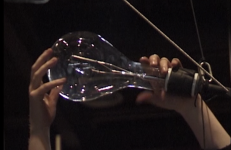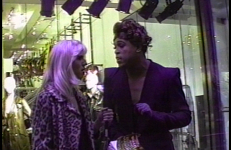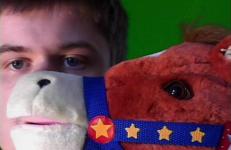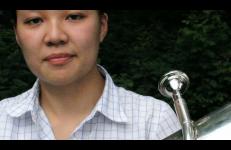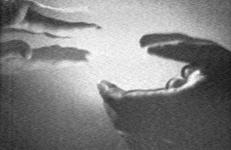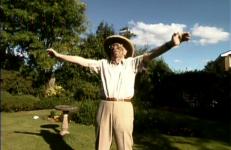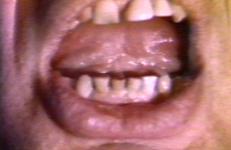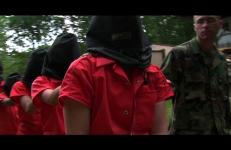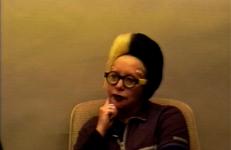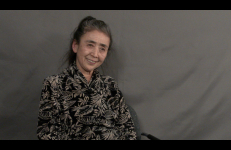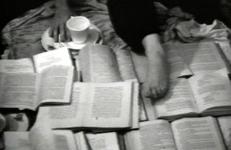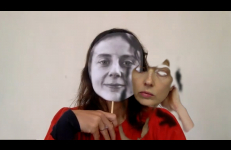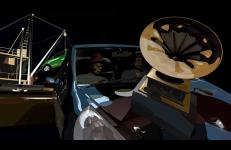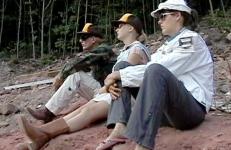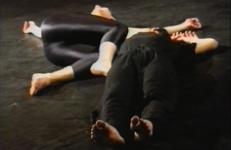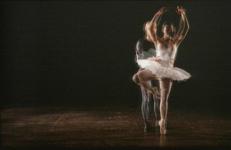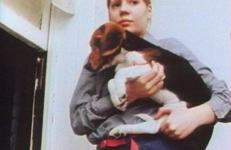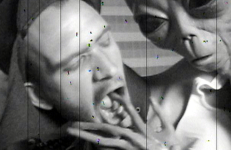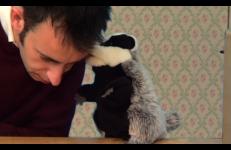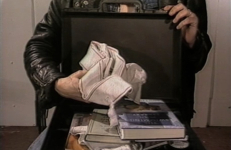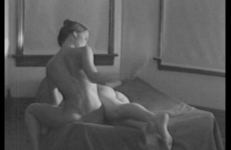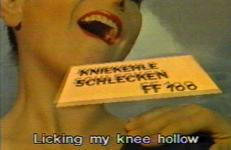Documentary of the New York experimental theater company The Wooster Group on tour in Glasgow, Scotland, 2000, installing their production of HOUSE/LIGHTS.
Performance
In One Man Ladies, Glennda Orgasm is joined by Vaginal Davis as they meet women on the streets of New York City to discuss Laura Schlessinger's book Ten Stupid Things Women Do to Mess Up Their Lives. The pair humorously explore the best ways modern women can find and secure a husband.
An episode of Glennda and Friends, hosted by Glennda Orgasm and Vaginal Davis.
Introduces the audience to the rockin' talkin' pony, who provides musical accompaniment for a series of Texas country-dance lessons.
This title is also available on Ben Coonley: Trick Pony Trilogy.
In this diptych, Yi-Ching Chen plays the lowest possible sound on her tuba and Magenheimer's own electronically synthesized voice sings a letter that Ada Byron, the world's first computer programmer, wrote to her mother. In the letter she describes what it felt like to discover the extraordinary power of her own vast intellect.
Text excerpted from a letter Ada Byron wrote to her mother.
Starting with an activity as basic as four hands clapping, Landry composes an arresting visual documentation of the fundamentals of music through a play of visual and sonic rhythms. Landry considers these movements “imaginary hand exercises for beginning drummers.” As disembodied hands swim through shallow space, a strobe light freezes them in the process of clapping, creating a mesmerizing play of eye-ear coordination.
This title was part of the original Castelli-Sonnabend video art collection.
Mr. Thomas is in the back garden, performing his new moves in the glorious sunlight, making things happen. Somewhere between ritual, a white suburban war dance and 1970's "keep fit" exercise to lovely music, Mr. Thomas tries to coordinate with the Black Blob, that persistently undermines the nature of his representational space...
And the song goes:
We've only just begun to live
White lace and promises
A kiss for luck and we're on our way...
Acconci's open mouth is framed by the camera in an extreme close-up, bringing the viewer uncomfortably close. A desperate sense of strained urgency comes across as Acconci gasps, "I'll accept you, I won't shut down, I won't shut you out.... Im open to you, I'm open to everything.... This is not a trap, we can go inside, yes, come inside...." Acconci continues to plead in this way for the length of the tape, his mouth held unnaturally wide open. The pathological psychology of such enforced openness betrays a desperate struggle to accept and be accepted by others.
Operation Atropos is a documentary about interrogation and POW resistance training. Director Coco Fusco worked with retired U.S. Army interrogators who subjected her group of women students to immersive simulations of POW experiences in order to show them what hostile interrogations can be like and how members of the U.S. military are taught to resist them. The group of interrogators is called Team Delta, and they regularly offer intensive courses that they call "Authentic Military Experiences" to civilians.
French performance artist Orlan uses her own body as a sculptural medium. Since 1990, she has worked on La Reincarnation de Sainte-Orlan, a process of plastic surgeries that she “performs,” making elaborate spectacles with surgeons dressed in sci-fi costumes and broadcasting the operations live via satellite to galleries worldwide. By exploring a total transformation of self, Orlan delves into issues of identity and the malleability of the flesh. She lives and works in Paris, exhibiting and performing internationally.
Interview by Shay Degrandis, via translator.
Born and raised in Japan and a resident of New York since 1976, Eiko Otake is a movement-based, interdisciplinary artist. She worked for more than 40 years as Eiko & Koma, but since 2014 has been working on her own projects. Her works often investigate themes of death and dying, history, and the persistence of collective memory. Eiko has also broadened her collaborative practice to create interdisciplinary work with artists from different backgrounds and disciplines, both alive and deceased.
A "young woman who finds herself surrounded by the relics of Western culture" is the subject of Richard Foreman's formal tableaux. The narration centers on a young woman's struggle to find a relation between her body and her self as mediated by language. The text is a poetry of formal relations that carries personal and historical implications, including the desires of the woman paradoxically voiced by a male narrator. The title suggests the vivid virtuality of dreaming; scenes repeatedly refer to both reading and sleeping.
In July of 1971, American artist Lee Lozano gave a talk at NSCAD art college in Halifax, called “The Halifax 3 State Experiment”. Stretching over 8 hours, and moving through multiple locations, Lozano delivered her extended lecture in three states - sober, stoned on weed, and high on LSD. Filmmakers Maïder Fortuné and Annie MacDonell take this event up as a point of departure for an investigation into Lozano’s thoughts, practice and daily life.
In July of 1971, American artist Lee Lozano gave a talk at NSCAD art college in Halifax, called “The Halifax 3 State Experiment”. Stretching over 8 hours, and moving through multiple locations, Lozano delivered her extended lecture in three states - sober, stoned on weed, and high on LSD. Filmmakers Maïder Fortuné and Annie MacDonell take this event up as a point of departure for an investigation into Lozano’s thoughts, practice and daily life.
Craig Owens (1950-1990) was a critic who wrote and lectured extensively on contemporary art. He showed particular interest in the issues of photography, postmodernism, feminism, and Marxist thought. A former associate editor for October and senior editor for Art in America, as well as professor of art history at Yale University and Barnard College, his writings were collected in Beyond Recognition: Representation, Power, and Culture (1994). Owens died of an AIDS-related illness in 1990.
Hurricane Katrina and the ensuing aftermath destroyed Noel's community and home. He is rebuilding, and as he rebuilds, he evokes the past through the enlistment of his personal archives. His memories are complicated by the tragic events that occurred on the Danziger Bridge on September 4th 2005. As Noel reflects back on what has been lost, the story that he tells about his neighborhood is affected by the story of innocent people gunned down while attempting to cross a bridge in search of safety, and for Noel their plight clarify many things.
Pagan and Christian souls clash in this student-collaborated mix of the defrocked and the deflowered.
Through a successful eBay bid in January of 2004, 1975 eteam dollars turned into 10 acres of personal U.S. property. The lot, a generic square within the larger American grid of townships, is located in the desert of Nevada. The closest settlement, Montello, "The town that refuses to die", is eight miles away, and the almost abandoned airbase Wendover, at the edge of the Salt Flats, is located about 30 miles SE. It's the 10-acre lot and its surroundings that started the eteam's search for solutions to problems, which were created by big systems that had made some small mistakes.
Unlike other sectors of Romanian civil society who gained status after December 1989, the gay community struggled for many more years with a legal ban imposed by a conservative political class subservient to the Orthodox Church. Against this background, I planned to make a tactical video whose leitmotif was a pas de deux performed by two male dancers.
The orchestra begins and a male and female dancer move from opposite sides of the stage. The dancers embrace and begin the White Swan pas de deux from the ballet Swan Lake. However this is not the ballet as it is normally performed. The choreography has been re-staged so that in every single frame the two original dancers have been replaced by the bodies of four new dancers. The movement remains continuous, the characteristics of the dancers’ movements and gestures the same, but in each frame a different person occupies the dancers’ body spaces.
Passage To The North is a companion film to Plowman's Lunch. It is set in the same location as Altered To Suit, and some of the players appear for a second or third time—Coosje van Bruggan and Kirsten Vibeke Thueson were in A Second Quarter; Thueson and Michael Shamberg were in Altered To Suit. Although there does not seem to be a relationship between the roles each has played from movie to movie, there are some similarities in the situations these characters find themselves in.
This chaotic fantasy involves an underground empire of Halloween-type entities that bedevil the surface people of earth with yellow rays that cause civilians to go on murderous rampages. The picture is crammed full of shlock-like sequences and non-stop visual assaults that drop like bombs yet raise a cloud of colorful opulence into the meager stratosphere of low budget movie making. Performed by real young people and somewhat chipped mannequins, The Passion Pot lives up to its name and is a stew of unbridled unmentionables.
The Badger Series has issues and attempts, each episode, to resolve them. Recasting a glove puppet show through his own present day sensibilities, Paul assumes the role of kindly uncle mentor to a household of capersome woodland creatures. Mortality, self-sacrfice, depression, altered states of consciousness and transgressive art practices are all explored as part of their everyday lives together.
Performing artist Neil Bartlett plays a gay lecturer whose attempt to go back into the closet is betrayed by the contents of his briefcase. In reaction to Section 28, the law that forbids the “promotion” of homosexuality in schools in the U.K., Pedagogue satirizes the upstanding instructor’s dramatic influence on his students.
The body as a percussive instrument.
Performers: Ellen Krueger & Monica Wilson
A Perfect Pair posits the idea that individual consumers are walking billboards for the products they use; product slogans and brand names peeking out from every crevice and cranny of the actors’ bodies. Export demonstrates how the body of the consumer, especially that of the female consumer, is co-opted by commercialism. In tongue-in-cheek fashion, A Perfect Pair celebrates the modern-day co-mingling of fetish objects, as a body builder seduces a prostitute at a bar saying, “Your eyes are the most beautiful blue ad-space. Your cheek could promote a Mercedes.




